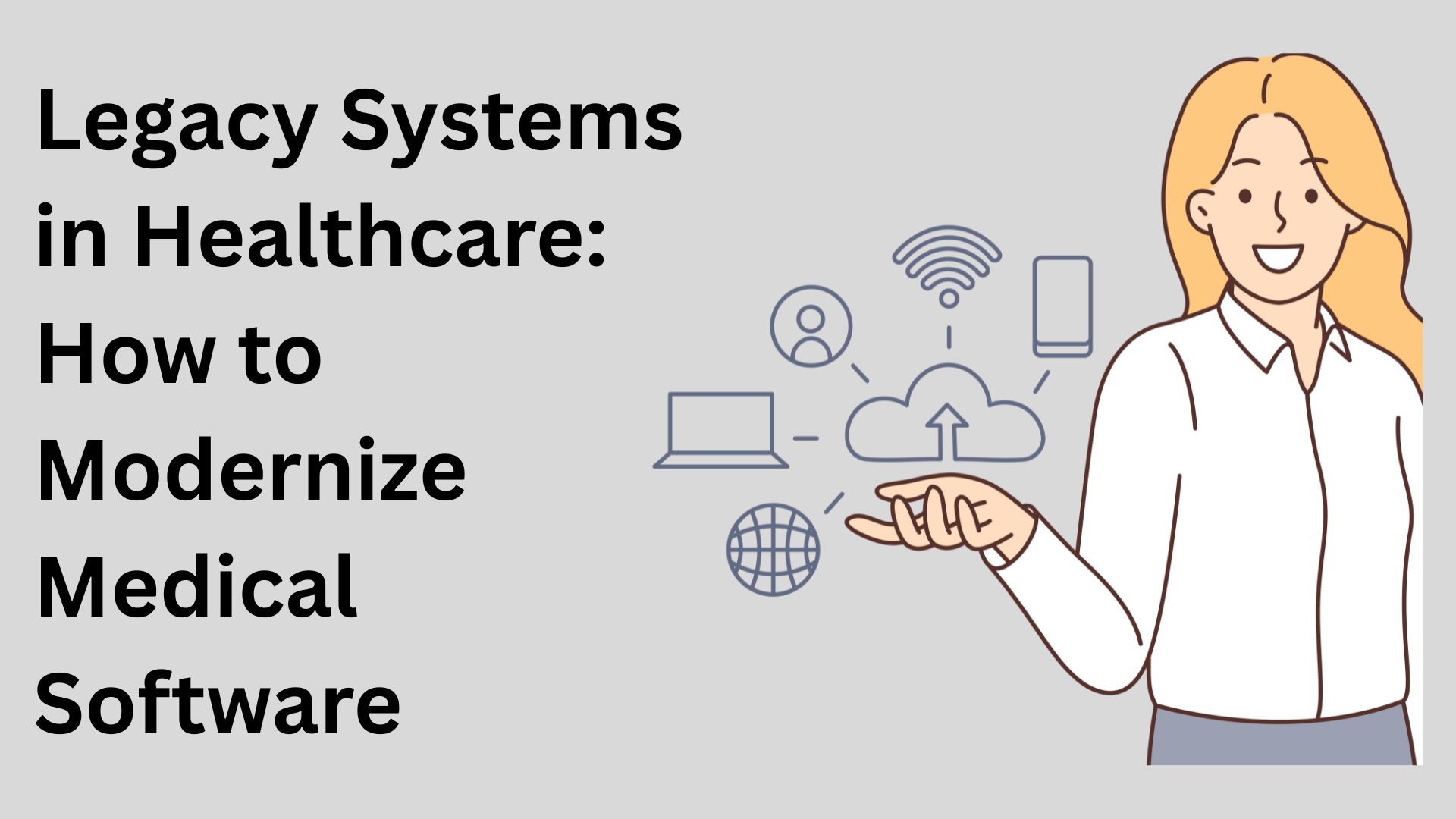Healthcare is a sector where technology isn’t just a convenience—it’s a lifeline. From patient records and diagnostic tools to billing systems and telemedicine platforms, medical software underpins the entire ecosystem of care delivery. Yet, many healthcare providers continue to rely on legacy systems—outdated software platforms that were once innovative but now lag behind modern demands. According to a 2023 survey by KLAS Research, nearly 65% of healthcare organizations still use legacy electronic health record (EHR) systems in some capacity. This reliance creates significant challenges, including security vulnerabilities, inefficiencies, and poor patient outcomes.
The need for modernization has never been more urgent. With rising patient expectations, stringent compliance standards, and the explosion of data from wearable devices and AI-powered diagnostics, healthcare software must evolve—or risk becoming obsolete. But how can healthcare providers tackle this mammoth task? This blog explores the nature of legacy systems in healthcare, the risks they pose, and practical strategies for modernizing medical software to drive better outcomes, efficiency, and security.
Understanding Legacy Systems in Healthcare
What Are Legacy Systems?
Legacy systems refer to older software or hardware that remains in use despite newer, more advanced technologies being available. In healthcare, these systems often include:
- Electronic Health Record (EHR) platforms built a decade or more ago
- Billing and claims management systems
- Patient scheduling and communication tools
- Laboratory information management systems (LIMS)
While these systems were designed for the needs of their time, many now struggle with interoperability, scalability, and security. They often run on outdated programming languages or operating systems, making maintenance costly and complex.
Why Are Legacy Systems Still Used?
Healthcare organizations face multiple barriers to upgrading:
- High Costs: Replacing or overhauling software requires substantial investment.
- Operational Disruption: Transitioning systems can interrupt patient care.
- Data Migration Risks: Moving sensitive patient data risks errors or loss.
- Regulatory Concerns: Compliance with HIPAA, GDPR, and other laws complicates upgrades.
Despite these challenges, sticking with legacy systems is increasingly risky.
Risks of Using Legacy Medical Software
1. Security Vulnerabilities
Older systems often lack modern encryption and patch management, exposing healthcare data to cyberattacks. According to IBM’s Cost of a Data Breach Report 2024, healthcare breaches cost an average of $11.45 million per incident—the highest of any industry.
2. Poor Interoperability
Legacy software often can’t communicate effectively with newer systems, creating data silos that hinder comprehensive patient care and analytics.
3. Inefficiency and High Maintenance Costs
Maintaining outdated systems demands specialized skills and frequent patching, which drives up IT budgets without delivering modern functionalities.
4. Suboptimal Patient Experience
Slow, unreliable systems can lead to delayed diagnoses, billing errors, and frustration for both patients and staff.
How to Modernize Medical Software: A Step-by-Step Approach
1. Conduct a Comprehensive Assessment
Before jumping into modernization, assess your current systems thoroughly:
- Inventory existing software and hardware
- Evaluate performance, security, and compliance status
- Identify critical workflows and integrations
This baseline understanding guides decision-making.
2. Define Clear Goals for Modernization
What do you want to achieve? Examples include:
- Improved patient data interoperability
- Enhanced security compliance
- Better user experience for clinicians and patients
- Scalability for future needs
Clear objectives help prioritize efforts.
3. Choose the Right Modernization Strategy
There’s no one-size-fits-all solution. Common strategies include:
- Rehosting (“Lift and Shift”): Moving applications to modern cloud infrastructure without changing code. This reduces hardware costs but doesn’t fix code inefficiencies.
- Refactoring: Updating code to improve performance and scalability while retaining core functionality.
- Rebuilding: Completely rewriting software from scratch for maximum flexibility and modern features.
- Replacing: Implementing off-the-shelf software solutions where custom-built systems are obsolete.
Each approach has pros and cons depending on budget, timeline, and technical complexity.
4. Prioritize Interoperability and Compliance
Modern healthcare software must seamlessly integrate with other systems and adhere to regulations such as HIPAA and the 21st Century Cures Act. Use standards like HL7 FHIR (Fast Healthcare Interoperability Resources) to enable data sharing across platforms.
5. Focus on Security by Design
Embed security at every stage of modernization:
- Implement encryption for data at rest and in transit
- Adopt multi-factor authentication (MFA) for users
- Regularly patch and update systems
- Conduct penetration testing and audits
6. Plan Data Migration Carefully
Migrating patient data is complex and risky. Follow best practices:
- Validate data integrity before and after migration
- Use automated tools to reduce human error
- Maintain backups throughout the process
7. Train Staff and Support Adoption
Modern software only delivers value if users adopt it. Provide comprehensive training for clinicians, administrative staff, and IT personnel.
Benefits of Modernizing Healthcare Software
- Improved Patient Outcomes: Faster access to comprehensive patient data supports accurate diagnoses and personalized treatments.
- Cost Savings: Cloud adoption and streamlined workflows reduce operational expenses.
- Enhanced Security: Protects sensitive health information against cyber threats.
- Better Compliance: Easier adherence to evolving regulations.
- Scalability: Ready for AI, telehealth, and big data analytics integration.
- User Satisfaction: Intuitive interfaces improve clinician productivity and patient engagement.
Real-World Examples
- Kaiser Permanente modernized their EHR system to improve interoperability across their 39 hospitals, resulting in a 30% reduction in duplicate testing.
- Mayo Clinic adopted cloud-based platforms to enhance telehealth capabilities, expanding patient access during the COVID-19 pandemic.
These examples show that modernization is not just a technical upgrade—it’s a strategic enabler of better care.
Conclusion
Legacy systems in healthcare present significant risks but also opportunities. By adopting a thoughtful, strategic approach to medical software modernization, healthcare providers can enhance patient care, improve security, reduce costs, and stay competitive in an evolving landscape. Partnering with a software modernization company can help navigate this complex journey, ensuring seamless integration, compliance, and user adoption.
Modernizing legacy healthcare systems is not merely about technology—it’s about transforming healthcare delivery for the better.
FAQs
Q1: What is a legacy system in healthcare?
A legacy system is an older software or hardware platform still in use, often lacking modern features, security, or interoperability, but critical to healthcare operations.
Q2: Why is it important to modernize legacy medical software?
Modernization improves security, efficiency, compliance, and patient outcomes, helping healthcare providers meet current and future demands.
Q3: What are common challenges in modernizing healthcare software?
Challenges include high costs, operational disruptions, data migration risks, and regulatory compliance.
Q4: How long does software modernization take in healthcare?
The timeline varies by project scope and strategy—anywhere from months for simple rehosting to years for complete rebuilding.
Q5: How can a software modernization company help?
They provide expertise in assessment, strategy, implementation, and training to ensure a smooth and compliant modernization process.



